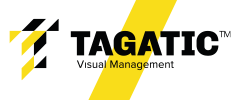Visual management - marking of production spaces
Why is it worth taking care of the correct marking of the production space?
The implementation of visualization systems allows faster and more effective response to any deviations than adopted standards. Thanks to the appropriate marking, it is possible to effectively manage the flow of materials, which improves work efficiency. The markings also increase the level of control over production, which translates into increased quality.
The implementation of visual management enables faster acquisition of knowledge by employees, which positively affects their productivity and commitment to work. Visual systems are also environmentally friendly because they allow you to reduce paper and other materials.
What are the types of markings in the production space?
- Safety marking - they inform about potential threats and risks, such as warnings against entering a dangerous area, or orders to wear personal protection.
- Information markings - enable identification of workplaces, machines and devices, and also inform about their functions and specifications.
- Qualitative markings - allow the quality of materials, products and processes, e.g. labels with information about the shelf life.
- Logistics markings - allow you to identify warehouses, sectors and shelves, which facilitates stock management and quick location of the necessary products.
- Organizational markings - inform about standards and procedures at the Department, such as waste segregation principles or instructions for proceedings in the event of an accident.
- Approximate markings - are used to mark directions and roads, e.g. road signs at the factory or marking emergency exits.
- Identification markings - allow the designation of individual elements of the plant equipment, e.g. plates with machine names or serial numbers of devices.
- Color markings - allow visual identification of individual sectors, separating risk zones or designation of elements based on their function.
What should be characterized by appropriate vertical and horizontal markings in the production space?
- Compliance with safety standards and standards, both domestic and international.
- Great visibility and ease of notice to minimize the risk of accidents and facilitate navigation after the plant.
- Transparency and understandability so that employees and bystanders can easily read the markings.
- Resistance to weather conditions and harmful effects of chemical and mechanical factors.
- Maintaining aesthetics and order in a production plant.
- Individualization if it is needed in the context of visualization and identification of the enterprise.
- Appropriate size and proportions, in accordance with the company's regulations and needs.
- Taking into account the easy possibility of updating and changes to reflect the current situation in the plant.
- Adaptation to the conditions in a given room, e.g. light (or illuminated) markings in dark places.
- Compliance with Lean Manufacturing principles to contribute to improving production processes and performance.
How does the correct marking increase safety in production halls?
Another important aspect is the reduction of the risk of accidents and injuries, because the marking allows for the separation of traffic zones, determining the road for internal and pedestrian vehicles, and the designation of places where materials and products can be safely stored. Marking also allows you to increase visibility and information, thanks to which employees are more aware of the environment in which they work.
Properly marked production space also allows quick orientation in the halls and increasing work efficiency, because employees do not waste time looking for the necessary tools or materials. It is important that the markings are made of durable and resistant materials to maintain their readability and visibility in the long run.
When designing and implementing appropriate vertical and horizontal markings, the specifics of a given production hall, its size and flow of materials and employees should also be taken into account. The marking should be clear, understandable and aesthetic to ensure comfortable and safe working conditions.

